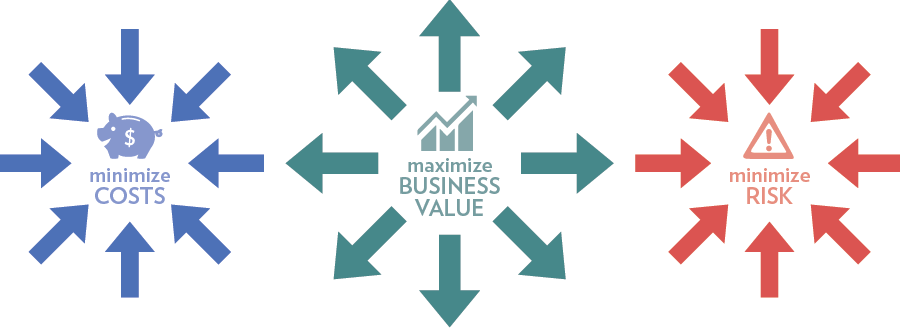What is Capacity Management in ITIL?
Capacity management is the practice of right-sizing IT resources to meet current and future needs. It’s also one of five areas of ITIL Service Delivery.
Effective capacity management is proactive, not reactive. Those doing well at capacity management make sure that business and service needs are met with a minimum of IT resources.
IT Tasks Included in Capacity Management in ITIL
There are many IT tasks that fall under the umbrella of a capacity management process.
Here are some of them:
Benefits of Implementation
Why Should I Implement Capacity Management?

Capacity management is critical to keeping IT costs down and quality of service up.
Most organizations use it to:
- Get more out of existing IT resources
- Improve IT cost per service unit positions
- Fine-tune applications and infrastructure components
- Improve performance, reduce consumption, and delay upgrades
- Eliminate redundant work
- Ensure consistent reporting
- Provision capacity efficiently
- Make informed business decisions using timely capacity and related cost information
- Provide insight into total cost of ownership (TCO) of IT upgrades and initiatives
- Predict future use based on growth levels
- Uncover bottlenecks with enough time to stop them before service is affected
Capacity management teams also have close ties to ITIL service level management and financial management areas.
In fact, capacity management processes lead to more thorough service level and associated financial information for the business. And this helps business leaders make more informed decisions.
Implementation Steps
5 Steps to Successful Capacity Management
Capacity management is often the starting point for an ITIL Service Delivery initiative.
Here’s why. It offers quick, early wins. And these typically create enough cost savings to fund the remainder of your ITIL project. In our experience, such savings are typically in the millions of dollars.
Plus, recovering implementation costs and showing success keeps the project afloat. (This also encourages upper management to stay the course and reduces resistance in your organization.)
As with all major projects, proper planning is key. If you’re looking to get your project off the ground, here are the five steps you should take.
1. Gather the Data
To plan for where your capacity is going, you need to know where you’re at. That’s why it’s important to identify a capacity manager and form a capacity management team.
This team can then:
- Develop a mission, including desired end-state goals, processes and responsibilities
- Assess the current state of capacity management
- Evaluate existing capacity management skills of the IT staff
- Take inventory of tools and software currently used for monitoring, capacity planning, performance management, and chargeback
- Collect budget details for capacity management work
- Perform a gap analysis to reveal areas that require process improvements, training, or software
2. Build the Plan
Next, you’ll need a plan for implementing capacity management.
Typically, your plan should:
- Establish the three major components of capacity management (people, processes, and tools)
- Outline the necessary costs and build a preliminary budget.
- Determine where capacity management should be placed in the organization
- Decide on either a formal, centralized capacity management team OR a matrixed organization
- Establish workflow, including data inputs, information outputs, and work processes
- Allocate sufficient time for training
- Identify any necessary work to acquire, consolidate, and/or implement capacity and performance tools
Once you have your plan (and budget) in place, you can submit it for approval.
3. Execute the Plan
Ready to act on your capacity management plan? Here’s what you’ll need to do.
Your first step is to build the team. This includes determining the size of the team and hiring the right people.
Next, you’ll need to document the processes. This is a lot of work, but it minimizes the impact of a disruption on day-to-day activities.
Processes usually cover performance management, capacity planning, modeling, performance data collection, storage, and reporting, and new application and major upgrade sizing.
Then you’ll need to acquire and implement tools that can do infrastructure monitoring, data collection, automated reporting, analytics, and modeling.
Your next task is to implement metrics for success. Be sure to tie your metrics to business value (not just technical measures) to report to upper management.
Finally, build the training materials and execute the training plan to bring everyone onto the same page.
4. Open for Business
Once you’ve executed on your plan, you’ll want to focus on managing performance. And a key part of managing is measuring.
For starters, choose a visible (but not so complex) area to measure. Typically, this will be a low-risk problem with wide visibility and significant benefit to the company.
Plan to gather at least 30 days of historical performance data before developing any trends or models. Start with simple, platform-specific capacity planning. Then work your way to end-to-end application transaction and business processes.
5. Review After Implementation
After capacity management is going full steam at your organization, it’s time to take a step back and assess.
List the lessons you’ve learned. And identify any changes that should be made to the process in the future.
We recommend performing a post-implementation audit after 6–12 months. This should give you plenty of time and data to determine what’s working and if there’s anything you can improve.
Getting Started
Take the Next Step
Read the guide:
Explore the software:
Watch a Demo > Product Info >
Continue Learning
ITIL Components:
Business Relationship Management
ICT Infrastructure Management
Application Management
Security Management
Service Delivery
- Service Level Management
- Financial Management
- Capacity Management (current)
- Availability Management
- Continuity Management
Service Support
- Incident Management
- Problem Management
- Configuration Management